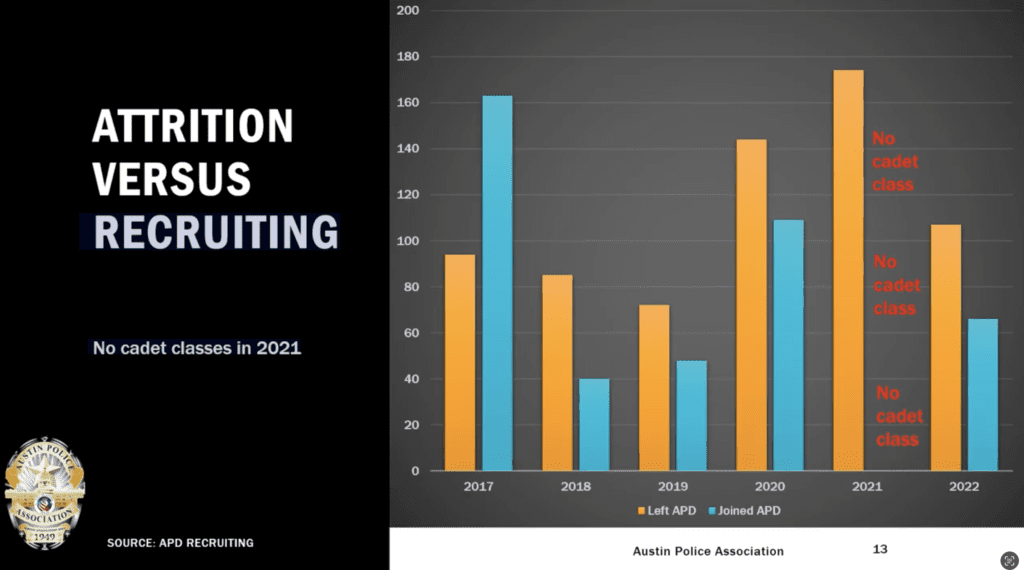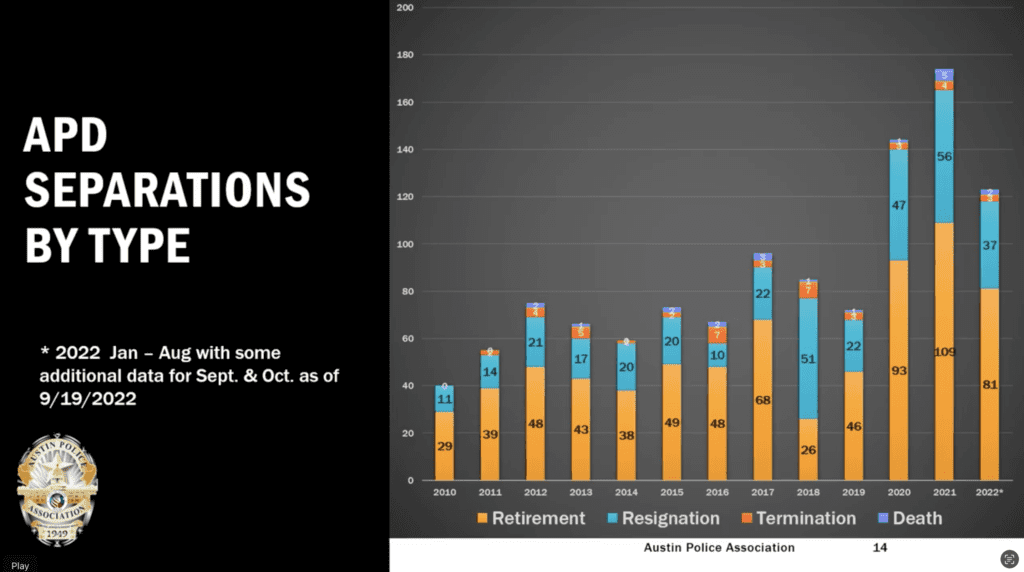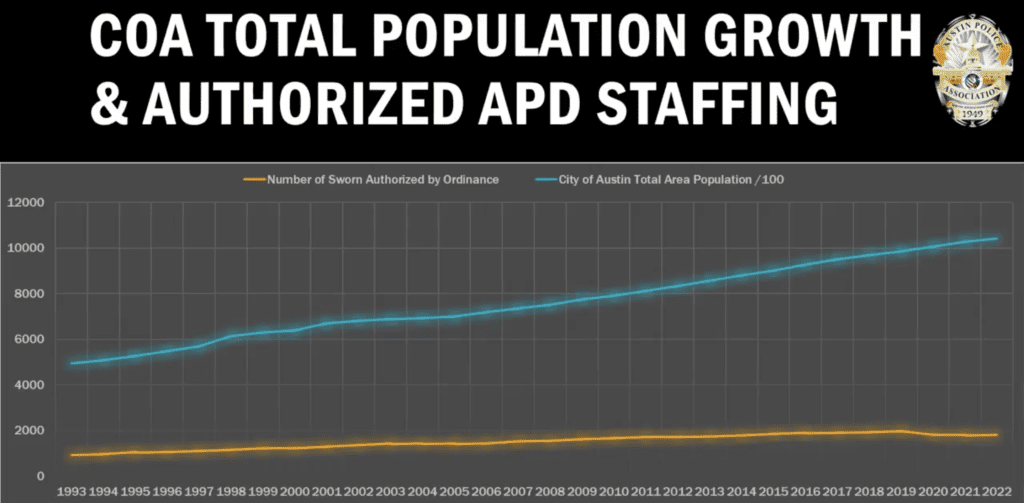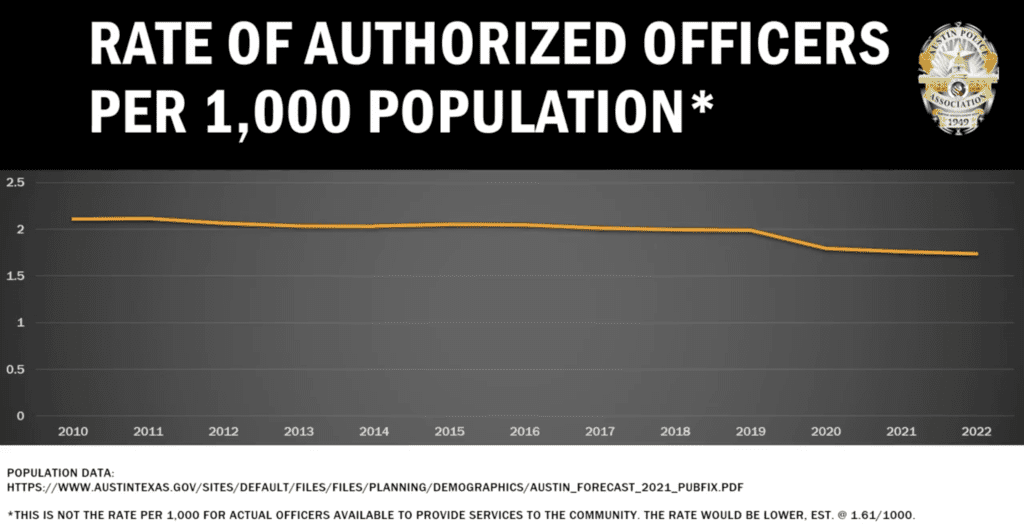Like California’s San Jose Police Department, the Austin Police Department is on track to go from over 1,800 officers to half that. I predict this happens before the end of this decade, if not sooner. APD is presently in a downward staffing trend that started with the voting down of the 2017 labor contract, a year of cancelled cadet classes, the election of a demonstrably anti-police district attorney, and now another round of the Austin City Council voting down of a completed labor contract with APD.
To point out where we currently are on APD’s staffing map, as of the start of this week APD had approximately 1,550 officers. In 2018, APD had over 1,800.
With Austin City Council not only declining to pursue another long-term labor contract but also firing the police-supportive City Manager on the same day, Austin Police staffing will continue to decline.
But these are only this week’s reasons for a decline in Austin’s police staffing. In this article, I will explain why Austin faces faces a stacked deck of long-term structural challenges to increasing or even maintaining its police workforce.
The City Council
The first structural challenge is a City Council that, wittingly or not, continues to push police staffing lower. To conceptualize this point, ask yourself, “When will a majority of council members vote in support of any item on the agenda that bolsters law enforcement staffing?”
If you say “but they support raises in police salaries,” I’ll counter by pointing out that APD’s yearly 1-4% “raises” have fallen short of the same year’s inflation rate for the past decade straight. APD officers receive yearly cuts in the purchasing power of their paychecks. The police association points this out in labor contract discussions to no avail.
City leaders confirm this by lamenting how few officers even live in the city anymore and how next to no officers live in the district they patrol. Between purchasing power cuts, million dollar home prices, and 6% mortgage rates, few officers can still afford to live in Austin. Many officers who could once afford and wanted to stay in Austin are now living in the nosebleed sections of the suburbs because they could not afford to stay in town.
Another important issue with City Council is illustrated by asking yourself, “When will a majority of council members side with the police over the usual Rolodex of activists who voice opposition to the dais during public commentary on police issues?” The same people who sank the labor contract in 2017 just repeated their success torpedoing another labor contract. If success is an encouragement, we’ll likely see more labor contracts shot down in the future, if another labor contract is ever even written.
It’s great to see people engaged in the democratic process, but Council’s ongoing unwillingness to say “enough” to police abolitionists’ efforts to abolish, disband, or depopulate the police department through seemingly benign tactics like “pausing” cadet classes or “waiting to see the will of the voters” is a strong indicator of further police staffing erosion.
The existence of a police force is a society’s way of outsourcing the responsibility and risk of self-defense and community safety to professionals. If Council wants Austin citizens to be able to pick up the phone, dial 911, and have a city employee respond to an innumerable array of safety issues, they must employ a police force. Otherwise, the order of things will slide from professional law enforcement and public order to vigilantism and anarchy. Portland and San Francisco are learning this the hard way.

Austinites need to make a deliberate choice about the degree of service and staffing level they want from the police department, and it starts with voicing their concerns to City Council. Whatever staffing level you choose for your department is fine as long as you can live with the outcome, but unless Council hears from you, people who think that abolishing policing is the way to go will continue making the choice for you.
A Less Attractive Pension
A new two-tiered, less-attractive police pension system for APD officers hired after January 1, 2022 presents a second structural challenge to maintaining staffing. This section of the article gets wonky, but it is critical to understanding why the historically low turnover rate for APD employees will increasingly become a thing of the past and push staffing lower.
The first thing to understand is the reason for the historically stable workforce. Defined benefit pensions incentivize longevity with an employer. The better the pension, the more people will spend their entire career with one employer.
Before January 1, 2022, Austin had one of the best police retirement systems in the country. Every officer hired prior to January 1, 2022 can retire with a 3.2% multiplier after a minimum of 20 years of service (23 years is full retirement, but officers can pay a large sum of money to “buy forward” and leave at 20 years).
Because of this pension system, officers who are within a tolerable timeframe to retirement will not leave APD no matter what. Civil service could be eliminated, they could be sent to work night shift patrol, an anti-police activist could become the next OPO director with the ability to fire them without cause, and they would still fight to remain on the job in order to reach retirement.
For officers further from retirement, let’s say 10 years away, many will have to weigh the challenge of starting over at another police academy or starting a new career in their 30’s or 40’s against the stress and challenge of sticking it out as an APD officer in this political environment. After 10 years on the job, many officers have kids in school, a spouse with a career and roots in the community, and a mortgage. Many of those officers will choose to stay, and a few will not.
For 20-something year old officers with another 14-18 years to retirement, it’s a question of whether they are willing to spend another decade or so under the present conditions or cut their losses and go work somewhere else.
And that is the “stable, low-turnover” portion of the workforce.

Now let’s talk about the potential for a police workforce with a higher turnover rate. Following the Austin Police Retirement System’s effort to change the legislation that governs APD’s pension, newly-hired officers enter under a second pension tier. Under the new program, officers have to stay on the job for a minimum of 25 years and age 50 for a 2.5% multiplier benefit. This means that a 21 year old cadet will have to work 29 years to reach APD retirement. This new system is too new to see how well it attracts applicants or retains employees, but I predict that it will not only attract and retain fewer people, but actively encourage some people to leave APD after about 2-3 years on the job.
First, the 25 year minimum time period largely mirrors other Texas cities’ pensions, like Fort Worth PD and Dallas PD. Austin no longer has the flagship pension that in the past attracted so many police applicants. Why apply to Austin when you can get the same financial deal with less workplace drama elsewhere?
Second, two to three years is when the “this is the best job ever and I would do it for free” phase of new officers’ career wears off. These 2-3 year officers will see their friends indicted, watch Council erode their working conditions, and realize that two and a half more decades under these conditions is neither desirable nor sustainable.
They will then say to themselves, “I’m about to be 30, I’d like to start a family, and I need to make a serious decision about where I want to spend the next two or three decades of my life.” At this point, if APD had a matching 401k system instead of a defined benefit pension like any private sector employer, it would be a simple choice whether or not to go work somewhere else. But since most police departments have a pension system that rewards longevity and financially discourages department-hopping, many officers who want to remain in policing as a career will realize that they need to pick a deparmtent they can be happy at long-term.
This is where Austin risks paying top dollar to become a training ground for other cities’ finest. Austin pays hundreds of thousands of dollars to recruit and train a single person from new cadet to independently-functioning and productive police officer and crime fighter. This includes the overhead costs of staffing a recruiting team, training academy, spending months under the guidance of a field training officer, and then spending a year or two under close supervision to just learn the ropes and develop the decision-making skills to succeed.
Consider the cost to train a person to go from a cadet to a detective. It take a minimum of four years before an officer can test to become a detective. By the time an APD detective has spent a few years becoming efficient and skilled as an investigator, the City has probably invested around three quarters of a million dollars worth of training, salary, healthcare, supervison and mentoring, and operations infrastructure getting them to that point.
Other cities recognize that they stand to gain financial windfalls by poaching these highly-trained and experienced APD officers away from Austin rather than paying for this training and experience themselves. Ask an APD officer how often they see other agencies’ recruiting ads in their social media feed and they will probably tell you, “daily, multiple times.”
Officers hired under the new pension system could spend four years on patrol, work a few years as a detective, and still have over two decades until they can retire. If a federal agency or any number of private companies or other cities offered those officers an easier job with similar pay, how many officers or detectives do you believe would choose to stay at APD? If you were buried in a stressful caseload, hearing KUT and KLBJ radio talk about another failed labor contract, and a private company offered you a $130,000 per year low-stress as a fraud investigator or security specialist starting next week on Monday morning, would you stay at APD?
An Increasing Workload


A third structural challenge for APD staffing is the vicious cycle of a growing workload shared by fewer and fewer officers. As the population and number of festivals and large events continues to increase at the same time staffing is falling, officers will be increasingly pressured or simply mandated to work more calls, more cases, more hours, and more unscheduled and unplanned assignments. At some point, officers will simply decide that money isn’t worth the stress and leave.
During the early stages of the staffing decline, APD tried to solve this issue by no longer responding to certain 911 calls. APD stopped dispatching officers to minor collisions, noise complaints, burglaries not in progress, thefts, and other incidents. 911 call takers instead routed callers to make reports over the phone instead of with an officer. Now where these reports went, who knows, but that’s a different issue.
As the staffing decline continued into 2022, patrol shifts became too short-staffed to respond to life-threatening 911 calls in a timely manner. In mid-2022, APD implemented a “patrol backfill” requirement in which every officer and detective not assigned to a patrol unit had to cover patrol shift vacancies. APD detectives still get assigned the same number of cases, but a fluctuating portion of their time is now spent in a patrol car answering 911 calls. This leaves less time to solve their cases. Recruiting, SWAT, Academy instructors, Organized Crime, and other personnel assigned to specialized units face the same challenge of getting their work done with less time to do so.
Fluctuating staffing levels affect how many officers and detectives must work backfill. When cadet class graduates and patrol staffing increases, non-patrol officers and detectives must work fewer patrol shifts. But when staffing falls, more and more of their workweek gets spent in a patrol car.
Depending on how many APD personnel retire or resign over the March 31, 2023 expiration of the labor contract, APD will have to come up with new ways to fill patrol vacancies. Will APD disband the few remaining specialized units? How many more detectives be sent back to patrol? Will APD respond to even fewer 911 calls? Seattle PD showed what is possible when it stopped investigating sexual assault cases with adult victims after the department fell from 1,315 officers in 2017 to the low 900’s today.
A Half-Sized Austin Police Department
If the Austin City Council decides to continue following San Jose’s path, the number of officers serving Austinites will fall by half from 1,800 to around 900, or even fewer. It is already becoming less of a question of, “How many of our senior officers will stay or leave” because there will be fewer and fewer senior officers left. It will increasingly become a question of, “How long can we retain the officers we hire before they quit?”
Even 900 may be a stretch. Seattle PD hired a grand total of 50 officers and lost 131 last year. If Austin can hire 100 officers per year, and the average tenure falls to 7 years, could a department of 700 officers be the new norm?
The answer to that is up to Austinites. If you want someone to even answer your 911 call, then you must vote for politicians who will make APD a more enjoyable place to work. If you want fewer cops, the status quo will get you there. Either way, other cities in Texas are more than happy to hire as many officers as Austinites will pay to train.

One of the best, “in- your- face”, “Just- the- facts” articles I’ve read in a decade. Is this what JOURNALISM is supposed to look like?
Pingback: Why APD’s Pension is Incompatible with Oversight - Power and Purpose